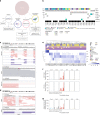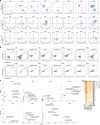Molecular profiling of driver events in metastatic uveal melanoma
- PMID: 32313009
- PMCID: PMC7171146
- DOI: 10.1038/s41467-020-15606-0
Molecular profiling of driver events in metastatic uveal melanoma
Abstract
Metastatic uveal melanoma is less well understood than its primary counterpart, has a distinct biology compared to skin melanoma, and lacks effective treatments. Here we genomically profile metastatic tumors and infiltrating lymphocytes. BAP1 alterations are overrepresented and found in 29/32 of cases. Reintroducing a functional BAP1 allele into a deficient patient-derived cell line, reveals a broad shift towards a transcriptomic subtype previously associated with better prognosis of the primary disease. One outlier tumor has a high mutational burden associated with UV-damage. CDKN2A deletions also occur, which are rarely present in primaries. A focused knockdown screen is used to investigate overexpressed genes associated withcopy number gains. Tumor-infiltrating lymphocytes are in several cases found tumor-reactive, but expression of the immune checkpoint receptors TIM-3, TIGIT and LAG3 is also abundant. This study represents the largest whole-genome analysis of uveal melanoma to date, and presents an updated view of the metastatic disease.
Conflict of interest statement
The authors declare no competing interests.
Figures




References
Publication types
MeSH terms
Substances
LinkOut - more resources
Full Text Sources
Other Literature Sources
Medical
Molecular Biology Databases
Research Materials
Miscellaneous

